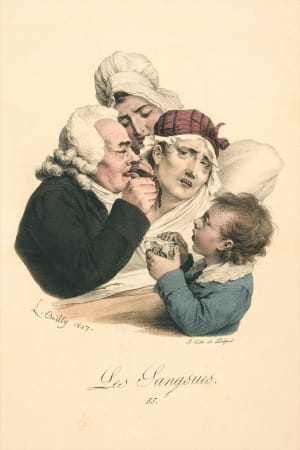Are Leeches Still Used In Medicine
Medicinal bloodletting has been practiced since the Stone Historic period. The popularity of leech therapy as a treatment has varied over time, just they notwithstanding have a apply in modern surgery.
The species of leech used for medicinal purposes is Hirudo medicinalis. Each leech tin consume about 5 to 10 ml of blood at each feeding, almost 10 times its own weight. They have three jaws and a hundred teeth. As they seize with teeth, they inject an anaesthetic into the skin and their saliva contains anticoagulants which finish the blood clotting.

Image from Pixabay, free to use (CC0 one.0).
So why are surgeons using the leech therapeutically once again? The medicinal use of leeches — scientifically known as hirudotherapy — re-emerged in the 1970s. Leeches have a useful function in reconstructive and microsurgery where they tin relieve venous congestion. For example, when a surgeon reattaches a severed finger, it is much more hard to repair the smaller veins than the big ones, so the finger can go bloated with blood. The hungry leech sucks out the backlog blood slowly and steadily, which keeps the finger healthy while the veins knit together and heal. The anticoagulants continue the blood thin, so that clots don't class and create problems. It'due south an constructive treatment with few side effects.
The history of the medicinal leech is fascinating. In antiquity, Pliny the Elder (AD 23–79) recommended leeches to treat phlebitis and haemorrhoids, while Egyptian medics believed the leech could help cure everything from fevers to flatulence. For centuries, patients were bled to restore a supposed imbalance in bodily humours.

Right: A medical practitioner administers leeches to a patient. Colour lithograph after L. Boilly, 1827. From the Wellcome Collection, gratuitous to employ with attribution (CC BY 4.0).
Medicinal leeching reached a pinnacle in the 18thursday and 19th centuries. The theories published by the Napoleonic surgeon François-Joseph-Victor Broussais created a stir and a market place for leeches. Leech trading became a lucrative business, with leeches exported across Europe and to the USA. France alone required millions of leeches annually. The use of medicinal leeches began to decline around the 1830s as diagnostic medical skills improved. John Haycraft'south publication,On the action of a secretion obtained from the medicinal leech on the coagulation of the blood (1884), showed that the blood in a leech'due south gut doesn't coagulate and the isolation of this anticoagulant, hirudin, past Fritz Markwardt in the 1950s, ensured the standing importance of the leech in medicine.


In the past, leeches were harvested from the wild and kept in leech jars filled with rainwater, which were often decorative. Leeches could be reused: you either waited until they'd digested their meal or persuaded them to disgorge the blood. Now to avoid infection, they are peculiarly bred and grown for medical use and humanely disposed of after one utilize. Modern leech therapy has fewer applications than in the past, simply is supported by scientific studies and instance reports; research continues into their use in a number of medical fields.
Susan Isaac, Information Services Manager
Are Leeches Still Used In Medicine,
Source: https://www.rcseng.ac.uk/library-and-publications/library/blog/why-you-should-love-a-leech/
Posted by: hsuprots1996.blogspot.com


0 Response to "Are Leeches Still Used In Medicine"
Post a Comment